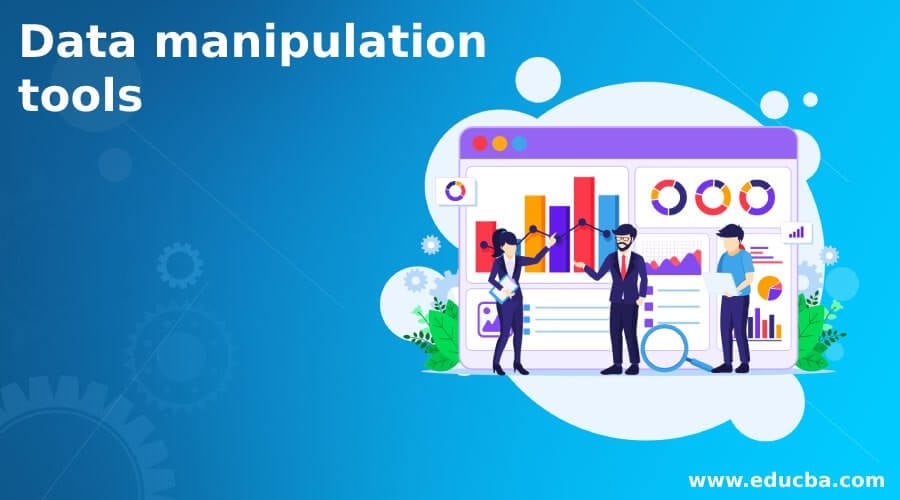Updated June 3, 2023

Introduction to Data manipulation tools
Data manipulation is changing data to make it easier to read. It is used on web server logs to allow website owners to view their most popular pages and traffic resources. Computers may also use data manipulation to display information to users more meaningfully, based on code in a software program, web page, or data formatting defined by a user. It translates data into the required format, making it easier to clean and map for extracting insights. Data manipulation tools make these tasks easier and arrange the data inappropriate manner. In this article, we will discuss these tools used for data manipulation.
List of Data manipulation tools
The list of data manipulation tools is as follows:
1. Tableau
Tableau is a data manipulation tool developed in Salesforce to connect with any database. It is mainly used in the Business Intelligence industry, and raw data is simplified easily to any format understandable by the users. It is also used in reporting and is mainly called a reporting tool. It helps to explore data, visualize and prepare reports for the same data. It can handle heterogeneous data by possessing data connectors or parsers for various sources that hold or store.
2. Excel
Users utilize Excel to automate various functions and manage data. With Excel, you can collect large amounts of data, which you can also put as rows and columns. We can enter the data through alphabets, numbers, graphs, charts, and pictures. With an Excel application, you can add, delete, modify, link, and relocate the data.
3. RapidMiner
RapidMiner, a data manipulation tool, is developed by Rapid Miner company; hence the name of this tool is RapidMiner. It is written using Java language. The fast miner can be used for predictive analysis, business applications, education and research, commercial applications, etc. It increases the speed of delivery as it follows the template framework. It not only increases the delivery speed but also reduces errors while transforming.
4. Talend
Talend, a data manipulation tool, combines data from different sources into a single view to get meaningful data that can help the company or organization improve their business by analyzing those data. It provides a solution for data preparation, quality, integration, and big data. Talend open studio helps in handling huge data with big data components.
5. KNIME
KNIME, Konstanz Information Miner, is a data manipulation tool that integrates various components for machine learning and data mining through its modular data pipelining concept called Lego of Analytics. It is a graphical user interface and uses JDBC to allow the assembly of nodes blending different data sources.
6. Apache Spark
Apache Spark is a quick data manipulation tool. Its main feature is memory cluster computing, increasing the application’s processing speed. Spark includes several operating charges, including batch applications, iterative algorithms, collaborative queries, and streaming. In addition to reducing the management burden of providing separate resources, TensorFlow handles all the workload in a system.
7. SAS
It stands for Statistical Analysis System, which presents SAS business intelligence and analytics solution. Developed by SAS Institute. The frequently used tool in data manipulation. It enables users to create and deliver predictive analysis because it has a pervasive set of machine learning (cleaning, transformation, pre-processing, filtering) algorithms and functions. It has strongly enabled Visualizations like 3-D graphs, scatter metrics, and self-organizing maps. It uses XML to describe tree modeling, and it has a flexible file operator for data input and output file formats.
8. QlikView
QlikView is a data manipulation platform that provides self-service BI to all corporate users. It provides a strong search mechanism for all the data sets, whether data is available directly or indirectly. It used the in-memory model of storing data. It enables you to ask and answer questions, follow your paths to insight, and make decisions with your colleagues. Our patented software engine is the core of QlikView and generates new flying data. It compresses information and stores it in memory, where multiple users can search it immediately.
9. Matplotlib
Matplotlib is a plotting library for the Python programming language and its numerical mathematics extension NumPy. It provides an object-oriented API for embedding plots into applications using general-purpose GUI toolkits like Tkinter, Python, Qt, or GTK. Matplotlib provides high-quality two-dimensional figures like bar charts, distribution plots, histograms, scatterplots, etc. It allows users to choose low-level functionalities like line styles, font properties, axes properties, etc., via an object-oriented interface or a set of functions.
10. TensorFlow
Google initially developed TensorFlow, one of the most popular open-source libraries for numerical computations using data flow graphs. In the Artificial Intelligence era, TensorFlow strongly supports machine and deep learning. Python-based can run deep neural networks for image recognition, word embedding, handwritten digit classification, and the creation of various sequence models.
Conclusion
This article discusses data manipulation tools such as Tableau, Excel, RapidMiner, Talend, KNIME, Apache Spark, SAS, QlikView, matplotlib, and TensorFlow. Each has its features, advantages, disadvantages, and limitations. Based on the requirements and ease, you can use these tools. Hope you enjoyed the article.
Recommended Articles
This is a guide to Data manipulation tools. Here we discuss the introduction and list of data manipulation tools, respectively. You may also have a look at the following articles to learn more –

